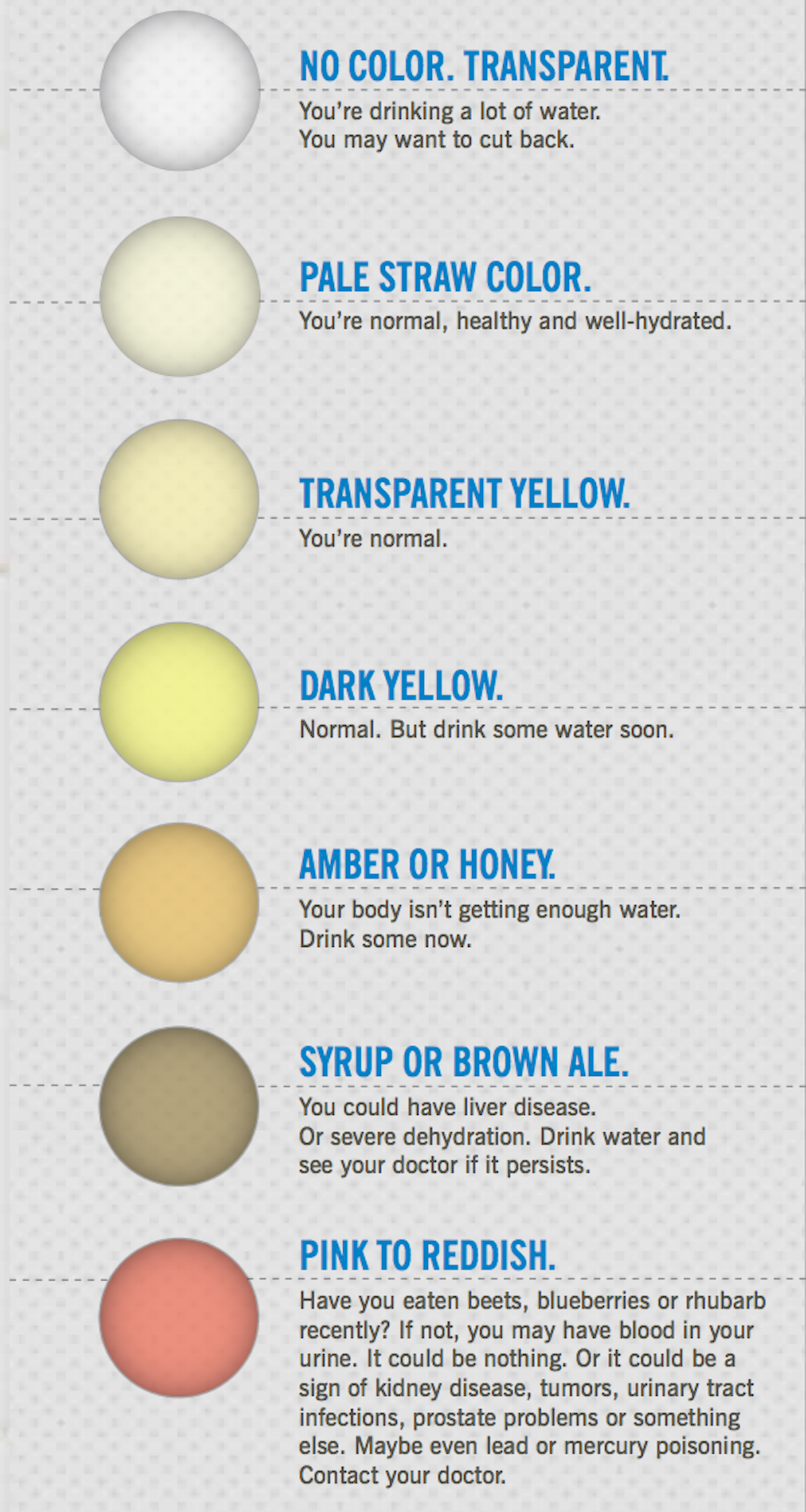Ever stared into the abyss of your toilet bowl after a trip to the bathroom and wondered, “Hmm, is this normal?” The color of your urine, often overlooked as a mundane detail, can be a fascinating window into your health. While the ideal hue is widely considered to be a pale yellow, the spectrum of pee colors is as diverse as the human experience itself. So, let’s dive into the intricacies of urine color – what’s normal, what’s not, and what it might be trying to tell us.

Image: theconversation.com
To understand what a “normal” pee color looks like, it’s helpful to know what causes the variations. The primary culprit is the pigment urochrome, a byproduct of the breakdown of heme, a molecule found in red blood cells. Urochrome, in varying concentrations, gives urine its characteristic yellowness, ranging from the pale yellow of a freshly squeezed lemon to the deep amber of a honeybee’s nectar. While urine color is often used as a quick health check, it’s important to note that one color doesn’t automatically equate to a specific condition.
The Spectrum of Pee: Decoding the Clues
Here’s a breakdown of common pee colors and what they might mean:
Pale Yellow: The Gold Standard
This is the color you’re aiming for. Pale yellow indicates that you’re adequately hydrated and your kidneys are efficiently filtering waste products. A healthy level of urochrome gives urine this light yellow hue, signaling that everything is functioning well.
Dark Yellow: A Sign of Dehydration
If your pee is taking on a darker amber color, it’s likely a sign that you’re not drinking enough water. Your body is conserving water, leading to a higher concentration of urochrome in your urine. A simple solution? Drink up! Hydration is crucial for your body’s overall well-being, and it’s remarkably easy to get back on track.

Image: blog.uvahealth.com
Clear or Very Light Yellow: Over-Hydrated?
While not necessarily a cause for concern, excessively clear or pale urine can signal overhydration. Yes, you can “drink too much water,” leading to a dilution of urochrome and a near-transparent pee color. However, for most individuals, this isn’t a major issue, but if it persists, consulting with a doctor is always a good idea.
Orange: A Possible Sign of Dehydration or Medications
A distinctly orange urine color could be a sign of dehydration, possibly exacerbated by certain medications, supplements, or vitamins. Some common culprits include:
- Vitamin B supplements: These are often culprits behind a bright orange hue, especially B12. A common dosage increase for B vitamins can lead to this change in urine color.
- Certain medications: Medications for infections, allergies, or other conditions can occasionally affect urine color, turning it a vibrant orange.
- Food dyes: Consuming excessive amounts of food dyes, particularly yellow or orange ones, can contribute to an orange tint in your urine.
Pink or Red: A Potentially Serious Concern
Pink or red urine can be a sign of blood in the urine, a condition called hematuria. While this can occur for various reasons, such as strenuous activity, kidney stones, or urinary tract infections, it’s always a good idea to consult a doctor. In some cases, red urine might be due to specific foods like beets or blueberries, or even food dyes, but it’s essential to rule out any underlying medical conditions.
Brown: A Cause for Investigation
Brown urine can be a sign of liver problems, dehydration, or certain medications. It’s essential to seek medical advice if you notice this color persistently. Some potential causes include:
- Dehydration: Brown urine can be a sign of severe dehydration, especially when accompanied by other symptoms like fatigue.
- Liver problems: Brown urine can be a sign of liver dysfunction, which warrants immediate medical attention.
- Certain medications: Medications containing phenazopyridine, used to treat urinary tract infections, can turn urine a dark brown or orange.
Blue or Green: An Unusual and Suspicious Color
Blue or green urine is a rare occurrence and often points to a medical condition or specific food intake. The color can be due to a number of factors, including:
- Medications: Some medications like methylene blue, used in certain medical procedures, can turn urine blue.
- Food dyes: Consuming significant amounts of food dyes, particularly blue or green ones, may momentarily create a blue or green hue.
- Rare genetic conditions: Some rare genetic conditions can affect the body’s ability to metabolize certain substances, potentially leading to blue or green urine.
Black: A Potential Sign of Liver or Kidney Problems
Finding black urine is a cause for serious concern and immediate medical attention. Possible causes include:
- Alkaptonuria: A rare, inherited metabolic condition that can lead to black or dark brown urine.
- Severe liver disease: Advanced liver disease can lead to the accumulation of bilirubin in the body, which can turn urine black.
- Melanosis: A condition that causes melanin, the pigment that gives skin its color, to build up in the urine, possibly leading to a black or dark brown appearance.
Other Factors Influencing Urine Color
While urochrome is the primary pigment responsible for urine color, other factors can influence its shade:
-
Diet: Certain foods, like beets, blueberries, and asparagus can temporarily change the color of urine.
-
Medications: As previously mentioned, certain medications, supplements, and vitamins can affect the color of urine.
-
Hydration levels: Fluids play a crucial role in diluting urochrome, affecting the overall color.
Making Sense of the Color Clues
Although urine color is a useful indicator, it shouldn’t be solely relied upon for self-diagnosis. If you notice unusual or persistent changes in your urine color, it’s crucial to seek professional medical advice. Your doctor can evaluate your overall health, conduct tests, and provide personalized guidance. While these changes in urine color might be harmless and temporary, catching any underlying medical conditions early is paramount for better health outcomes.
What Color Is Pee Supposed To Be
Conclusion
While your pee may seem like a mundane bodily function, it’s a powerful indicator of your health. By paying attention to its color and noticing any unusual changes, you can become more aware of your body’s signals. Remember, a pale yellow is generally considered normal, but if your urine takes on an unusual color or you experience other concerning symptoms, it’s always a good idea to consult with a healthcare professional. Observing the “rainbow” in your toilet bowl can be a valuable step towards understanding your overall health and well-being.






